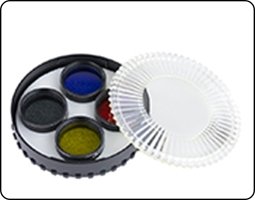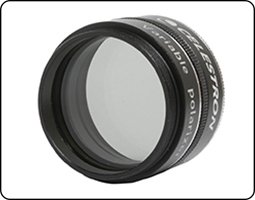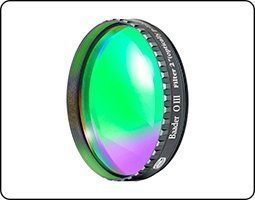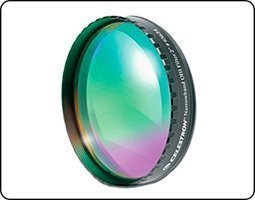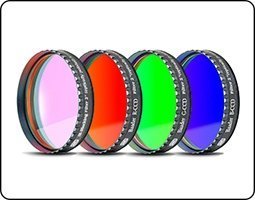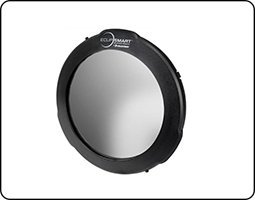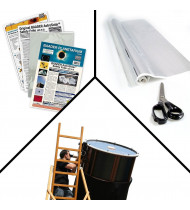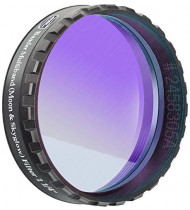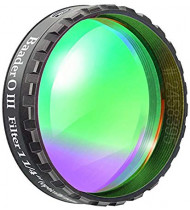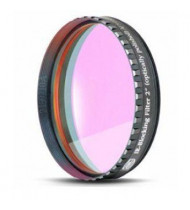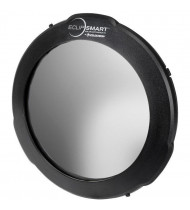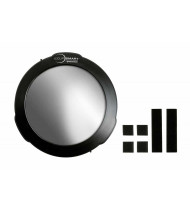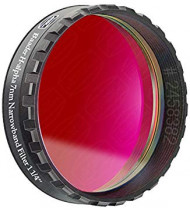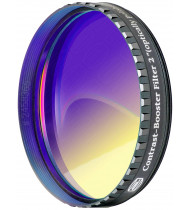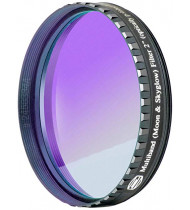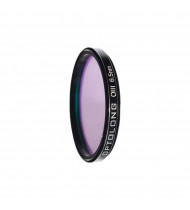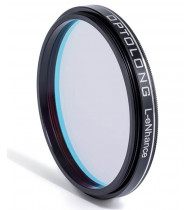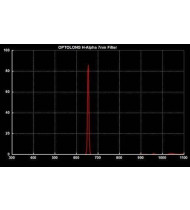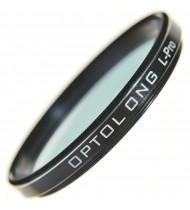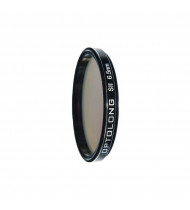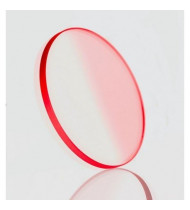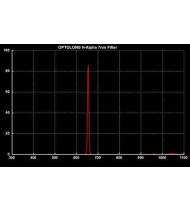

- Premium grade H-alpha interline chip CCD-filter for fast optical systems f/10 to f/2.8
- IR-blocked
- NO halos, NO reflections, NO ghosting
- non-ageing sealed coating edges
- 1¼" Contrast Booster Filter that completely eliminates false color
- Removes the bluish "hue" (=lack of contrast) during lunar, planetary, solar and terrestrial observation
- Boosts contrast and sharpness for fast achromatic telescopes - with over 95% transmission
- Planeoptically polished, non-ageing sealed coating edges
- AstroSolar® Safety Film 5.0 for solar observation and photography at high magnification, telescope quality, Optical Density (OD) = 5.0
- Safe for visual solar observation (with additional optics) and imaging
- This highest precision film consistently produces strehl ratios of 94 to 96 percent at interferometric tests – thus it performs optically like a Fluorite Triplet Lens by Carl Zeiss or Astro Physics
- AstroSolar Safety Film is best suited for precision work with all astronomical telescopes and binoculars – just as well as for all photographic camera- and tele-lenses
- For more than 25 years on the market, the only film-material made to not deteriorate the optical wavefront, it does allow to attain high magnification with any long-range optics without reducing sharpness or contrast of the solar surface.
OUT OF STOCK
- The best visual and photographic filter for contrast enhancement for all telescopes, without loss of image brightness!
- The effect of the element neodymium as filter material is very impressive. When added to optical glass, it enhances contrast, enhances the red colour in the image (especially with Mars and Jupiter) and it darkens the spectral region which is particularly marked by street lamp light, which is the biggest contributor to the nightly "Skyglow".
- Planoptically polished and MC-coated – with IR-cut coatings!, without any loss of sharpness as a single filter in front of a binocular or be used for afocal projection with digital cameras (far from the focal point!)
- The IR spectral range is blocked making stars much sharper when used with dSLRs.
Baader O-III Filter 1.25" (10nm) visual
US$ 83.32- ultra hard and bright O-III visual contrast for 6" and larger telescopes
- no visual color fringing, just pure O-III
- non-ageing sealed coating edges
Baader UV/IR Cut / L-Filter 2"
US$ 85.95- Blocks UV below 400nm and IR above 680nm
- Maximum transmission, scratchproof hard coated
- non-ageing sealed coating edges
- EclipSmart solar filter for Celestron SC8 and EDGE HD 8 optical tubes.
- Premium grade H-alpha full frame chip CCD-filter for fast optical systems f/10 to f/2.8
- IR-blocked
- NO halos, NO reflections, NO ghosting
- non-ageing sealed coating edges
Baader Contrast Booster Filter 2" (50.8mm)
US$ 118.40- 1¼" Contrast Booster Filter that completely eliminates false color
- Removes the bluish "hue" (=lack of contrast) during lunar, planetary, solar and terrestrial observation
- Boosts contrast and sharpness for fast achromatic telescopes - with over 95% transmission
- Planeoptically polished, non-ageing sealed coating edges
Baader H-alpha 35nm CCD Filter 2" (50.8mm)
US$ 127.17- Premium grade H-alpha interline chip CCD-filter for fast optical systems f/10 to f/2.8
- IR-blocked
- NO halos, NO reflections, NO ghosting
- non-ageing sealed coating edges
Baader Neodymium 2" (Moon & Skyglow)-Filter
US$ 127.17- The best visual and photographic filter for contrast enhancement for all telescopes, without loss of image brightness!
- The effect of the element neodymium as filter material is very impressive. When added to optical glass, it enhances contrast, enhances the red colour in the image (especially with Mars and Jupiter) and it darkens the spectral region which is particularly marked by street lamp light, which is the biggest contributor to the nightly "Skyglow".
- Planoptically polished and MC-coated – with IR-cut coatings!, without any loss of sharpness as a single filter in front of a binocular or be used for afocal projection with digital cameras (far from the focal point!)
- The IR spectral range is blocked making stars much sharper when used with dSLRs.
Optolong OIII Filter 6,5nm 1.25" (31.8mm)
US$ 130.68Extra Narrowband OIII-CCD 6.5nm filter is designed for nebula observation allowing 6.5nm bandwidth of light centered on a wavelength of 500nm through, which corresponds to OIII emission lines, and reducing the transmission of certain wavelengths of light, specifically those produced by artificial light including mercury vapor, and both high and low pressure sodium vapor lights and the unwanted natural light caused by neutral oxygen emission in our atmosphere (i.e. skyglow).
L-eNhance 1.25 "Optolong filter (M28x0.75) 31.8mm - Recommended for: shooting in double pass band (H-Alpha, OIII and H-Beta) with CMOS or CCD color cameras or DSLR
Optolong H-Alpha 7nm 1.25" (31.8mm) v.2
US$ 135.94Bester H-alpha-Linienfilter für die Astrofotografie von Emissionsnebeln mit höchstem Kontrast und der Wiedergabe zartester Nebeldetails.
♦ schmalbandiger (<=7 nm) Linienfilter für wichtige Nebellinie
♦ bevorzugt für CDD-Kameras mit Full-Frame-Transfer-Technik
♦ 2 mm dick und somit homofokal mit vielen anderen Filtern von Optolong
♦ Interferenzfilter
♦ feinoptisch poliert
♦ mehrschichtig hartvergütet - reflexfrei und weitgehend kratzfestOptolong L-Pro Filter 1.25"
US$ 144.71The L-Pro Astrophotography CCD filter is a filter for improving the contrast of deep-sky objects and dampening the sky background.
- blocks UV and IR (700 - 1100 nm)
- high transmission at passband
- improved color balance for DSLRs and One-Shot Color Astro Cameras, e.g. ASI Color Cameras cooled or uncooled by ZWO.
- high optical quality
- in 1.25" filter cell
- The L-Pro Nebula filter permits roughly 3x longer exposure times than without a filter and therefore improves contrast significantly.
Baader O-III Filter 2" (10nm) visual
US$ 144.71- ultra hard and bright O-III visual contrast for 6" and larger telescopes
- no visual color fringing, just pure O-III
- non-ageing sealed coating edges
Optolong SII Filter 6.5nm 1.25" (31.8mm)
US$ 148.22Extra narrowband SII-CCD 6.5nm filter (Sulful II for CCD) is designed for nebula observation allowing 6.5nm bandwidth of light centered on a wavelength of 672nm through, and reducing the transmission of certain wavelengths of light, specifically those produced by artificial light including mercury vapor, and both high and low pressure sodium vapor lights and the unwanted natural light caused by neutral oxygen emission in our atmosphere (i.e. skyglow).
Optolong H-Alpha 7nm 36mm
US$ 153.48The H-ALPHA 7nm filter is the most popular narrow-band filter that allows a 7nm bandwidth centered on a 656nm wavelength.

